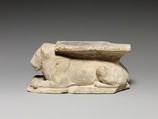Model of a temple door bolt with recumbent lion
Late Period–Ptolemaic Period
Small Late Period and Ptolemaic reliefs or sculptures that depict a subject in a partial or unfinished way but are themselves finished objects constitute a special class of object. Guidelines like those for artists are often prominently exhibited as part of the object, although, in fact, many instances can be noted where the object simply could not serve as a suitable model for a traditional formal Egyptian representation. Personifications of kingship, figures that may represent the now emerging demigods Imhotep and Amenhotep Son of Hapu, and popular gods like Harpokrates or Isis, are heavily represented within the corpus.
Taken together, the figures represented and the other features indicate the reliefs and sculptures of this class, sometimes called by Egyptologists "sculptor’s models / votives," were the material of a donation practice, perhaps connected with the prolific temple building of these centuries. Unfortunately there is little to illuminate us about the mechanics of such a donation practice.
This elaborate sculpture belongs to the group of architectural elements depicted among the sculptures. This model represents a temple door bolt. Such bolts take the form of a rectangular bronze slider decorated with a recumbent protective lion that slides from a door leaf into the hole in an adjacent door jamb.
Link to a blog about Ptolemaic Art at The Met
Nile and Newcomers: A Fresh Installation of Egyptian Ptolemaic Art
Due to rights restrictions, this image cannot be enlarged, viewed at full screen, or downloaded.
This artwork is meant to be viewed from right to left. Scroll left to view more.






